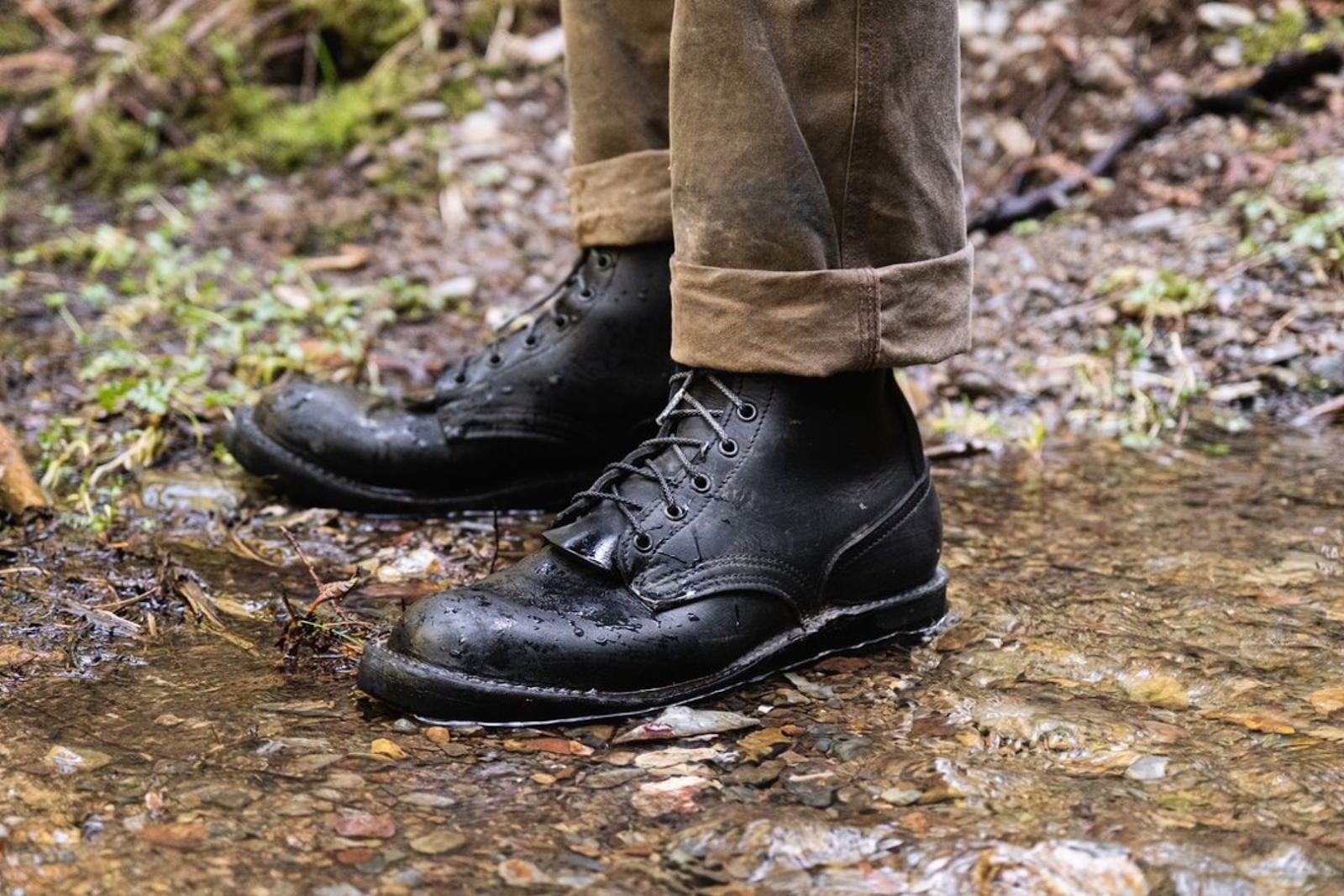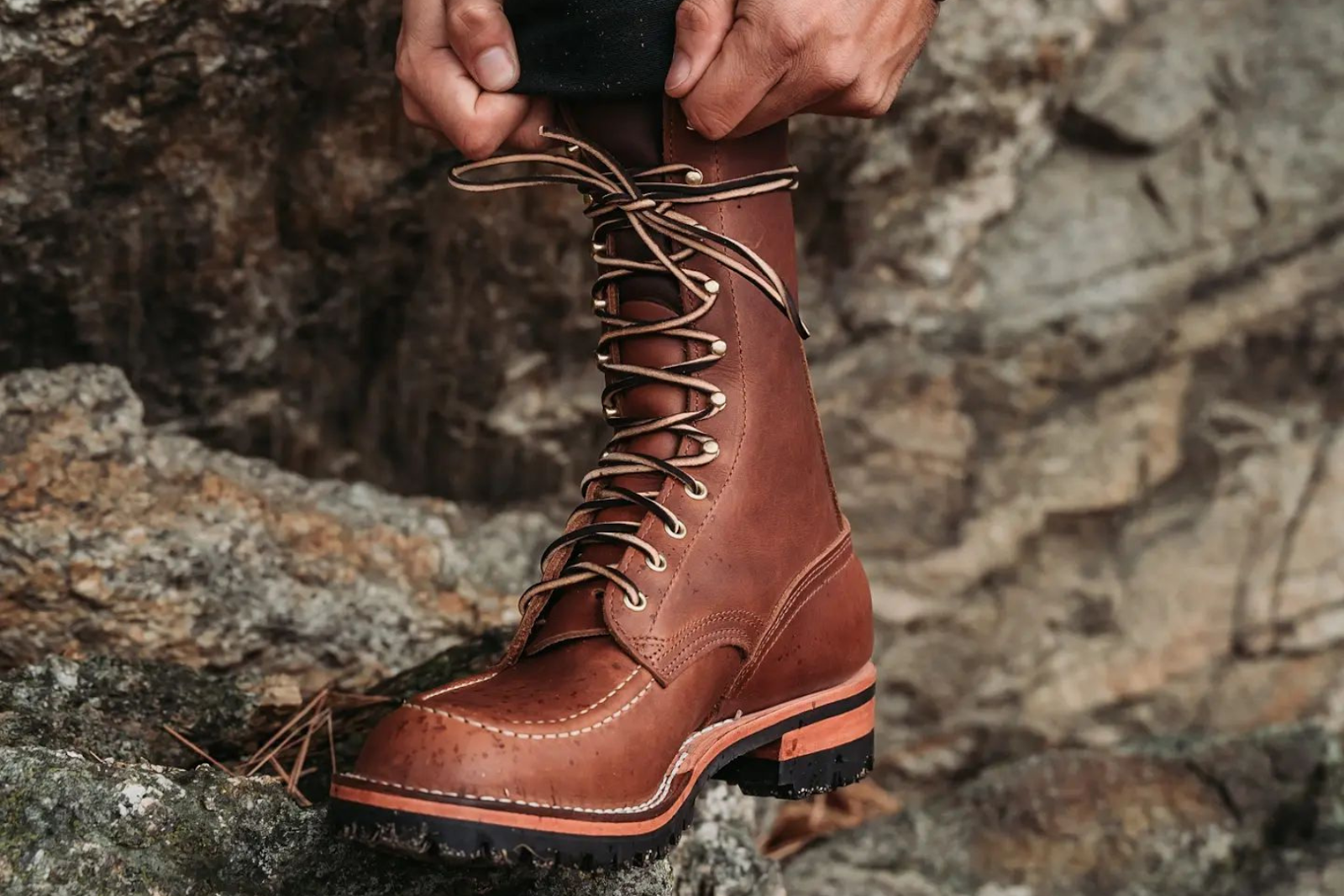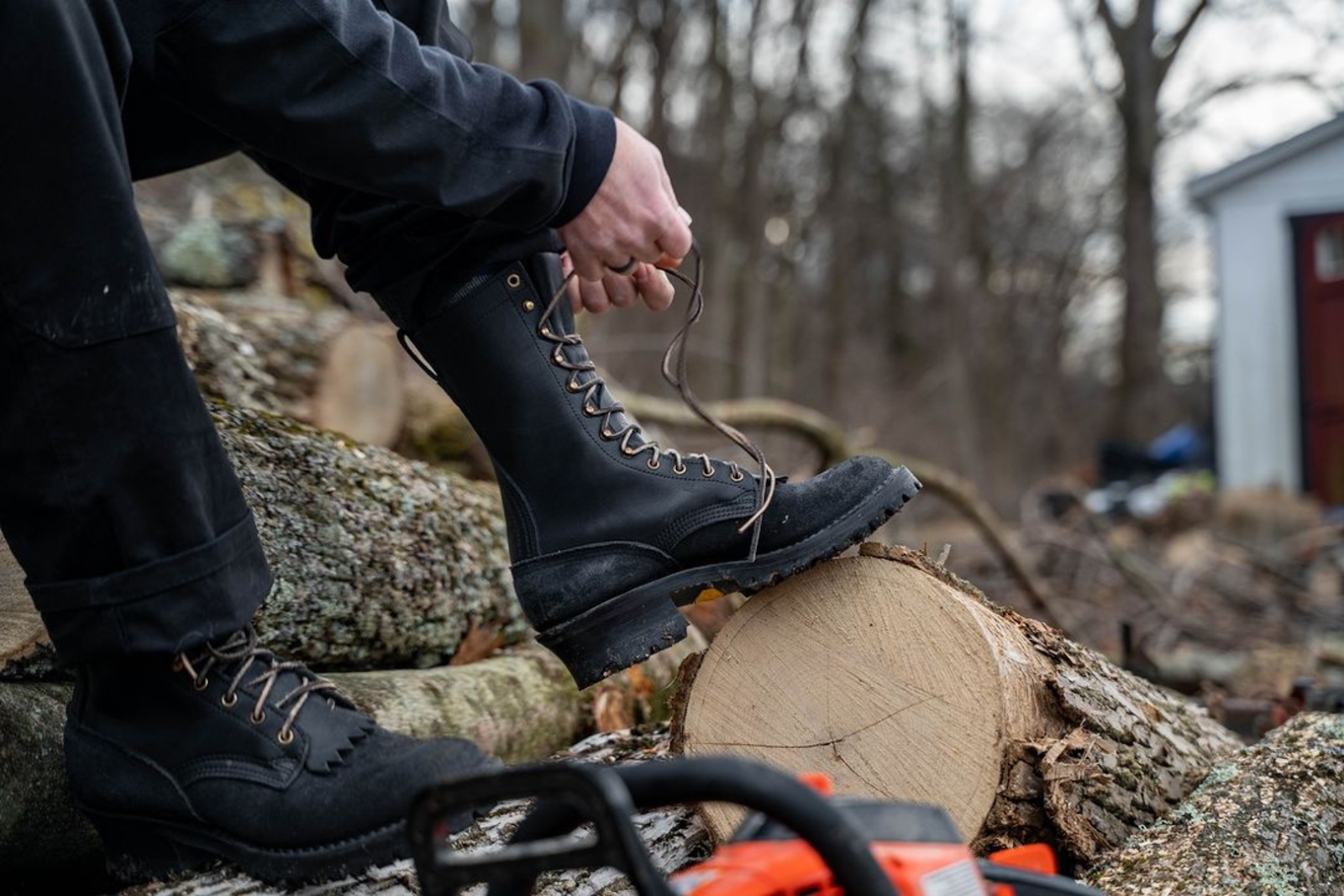Key Takeaways
- Choosing for Durability: Opting for boots with high-quality materials and robust construction methods.
- The Right Fit is Fundamental: Measuring your feet correctly and selecting the proper size and fit are essential to ensure comfort and prevent foot health issues.
- Maintenance is Key to Longevity: Regular cleaning, conditioning, and appropriate storage are vital practices to preserve the appearance and functionality of your boots over time.
Selecting the right men's boots is more than a fashion choice; it's an investment in your foot comfort, protection, and personal style. Whether trekking through rough terrain, heading to a formal event, or enduring long workdays, the right boots can make a significant difference.
In this article, we'll cover the essentials to help you make an informed decision. From understanding your needs to considering materials, fit, and construction, we'll walk through the necessary steps to choose boots that aren't just a purchase but a part of your journey.
Find your perfect men's boots with our ultimate guide. Discover comfort, protection, and personal style for every occasion. Start your journey to the ideal footwear today!
Understanding Your Boot Needs
Assessing Your Environment And Usage
To pick the right boots, start by assessing the environments you'll face and the activities you'll undertake. If your daily routine involves rugged outdoor work, you'll need boots that offer robust protection and support.
Urban dwellers might look for something sleek yet comfortable for pavements and public transport. In contrast, occasional hikers will benefit from boots designed for natural terrains with sturdy traction.
Identifying Your Style Preferences
While utility is paramount, you don't need to compromise on style. Boots come in various designs that can complement your wardrobe. Consider whether you prefer the clean lines of a dress boot or the more structured look of a work boot.
Your choice should resonate with your personal aesthetic and lifestyle, ensuring your boots are both a practical and stylish addition to your collection.
Importance Of Longevity And Quality
Quality boots are an investment. The right pair should last years, not months, so prioritize durability when making your selection. Inspect the build quality, materials, and reputation of the manufacturer.
Boots from a well-regarded brand may come with a higher upfront cost, but the longevity and performance they deliver typically justify the investment.

Step Up Your Boot Game With Nicks Boots
Embrace the craftsmanship and reliability of Nicks Boots—the last pair of boots you'll ever need. |
Understanding Boot Materials
The materials used to manufacture men's boots directly impact their durability, comfort, and suitability for different environments. Leather, commonly used by premium brands like Nicks Boots, is renowned for its resilience and ability to mold to the wearer's feet over time. Synthetic materials offer water resistance and are often lighter, while rubber soles provide grip on slippery surfaces.
The choice of material determines the boot's breathability, waterproofing capabilities, and its ability to withstand daily wear and tear. When choosing a boot, it's crucial to consider the type of material to ensure it aligns with your needs and the conditions you'll encounter.
Types Of Men's Boots
Work Boots
Work boots are engineered for safety and durability. They are indispensable for anyone who spends a lot of time on their feet, especially in hazardous environments.
Key features often include steel toes, slip-resistant soles, and reinforced construction. When choosing work boots, consider the specific demands of your job and ensure they meet all necessary safety standards.
Dress Boots
Dress boots offer a perfect blend of sophistication and practicality. These boots are appropriate for formal occasions or office environments, providing a polished look while offering more protection and support than traditional dress shoes.
When selecting dress boots, consider the shape, heel height, and leather finish for a boot that complements formal wear while still offering comfort.
Hiking Boots
Hiking boots are specifically designed to tackle outdoor terrains with ease. They offer exceptional support, durability, and protection against the elements.
Features to look for include waterproof materials, ankle support, and aggressive tread patterns. Choosing the right hiking boots can mean the difference between enjoying your outdoor adventures and ending a trail with sore feet.
Material Matters
Leather: Classic And Durable
Leather is a time-honored material in boot construction known for its durability, breathability, and ability to mold to the wearer's foot over time. Different types of leather offer various textures and finishes; for example, full-grain leather is particularly resilient and develops a unique patina with age.
When choosing leather boots, consider the climate you live in and the level of care you're willing to provide to maintain the material.
Synthetic Materials: Modern And Functional
Synthetic materials such as nylon or artificial leathers have become popular for their lightweight, waterproof, and often more affordable nature. These materials are particularly suited for boots that require less break-in time and more resistance to certain chemicals or abrasions.
Keep in mind that synthetics might not offer the same longevity or rich character as natural leather.
Caring For Different Materials
The lifespan of your boots significantly depends on maintenance. Leather boots require regular cleaning, conditioning, and protection from excessive moisture, while synthetic boots often need minimal care, usually a simple wipe-down and occasional treatment for waterproofing.
No matter the material, proper care is essential to keep your boots in prime condition for years to come.
Fit And Comfort
Finding The Right Size
Selecting the correct size is crucial when it comes to boots. Ill-fitting boots can cause discomfort, blisters, and long-term foot issues.
Ensure there's enough space to wiggle your toes and that there's no excessive pressure on the sides of your feet. It's often recommended to try boots on later in the day when your feet have naturally expanded.

Recognizing A Good Fit
Apart from size, the fit involves the overall shape of the boot conforming to your foot. Pay attention to the width, arch support, and the space around the heel. A proper fit should feel snug but not tight, with the foot securely in place to avoid slipping.
Remember, some materials, like leather, will stretch slightly with wear, so factor this in when assessing the fit.
Insole Support And Comfort Features
The insole plays a critical role in comfort, especially if you're on your feet all day. Look for boots with quality insoles that provide proper arch support and cushioning. Some boots come with removable insoles, which can be replaced with orthopedic or custom inserts if needed.
Additional comfort features might include padded collars, breathable linings, and shock-absorbing soles.
The Construction Of Quality Boots
Understanding Boot Construction
The way a boot is constructed impacts its durability, flexibility, and repairability. Goodyear welt, Blake stitch, and cement construction are common methods, each with its benefits and drawbacks.
Goodyear welted boots, for example, are known for their exceptional durability and ease of resoling, while cemented boots tend to be lighter and less expensive but harder to repair.
Sole Design And Traction
The sole contributes significantly to the boot's functionality. A heavy-lugged sole offers high traction for work or hiking boots are suitable for muddy or slippery conditions.
For urban environments or formal occasions, a sleeker sole with fine treads is more appropriate, offering a refined look and enough grip for everyday wear.
Stitching Quality And Durability
Stitching not only adds to the aesthetic of the boot but also reinforces its strength. Inspect the stitching for evenness and lack of fraying. Double or triple-stitched seams typically indicate a boot built to withstand stress, ideal for work boots or other demanding uses.
High-quality stitching ensures the boot remains intact, providing support and protection over time.
Design And Aesthetics
Classic Designs vs. Modern Trends
When it comes to boot design, balancing classic appeal with modern innovation is key. Timeless boot styles like the Chelsea or Chukka have remained popular over the years due to their versatility and enduring design.
Yet, there are always new trends emerging that offer updated takes on these classics, providing modern men with a range of options to express their personal style.
Color Choices And What They Mean
Color is a defining element of a boot's aesthetic and can dictate its versatility. Black and brown are traditional choices that offer maximum compatibility with various outfits. However, bolder colors or unconventional tones can make a statement and show off personal style.
Remember that lighter colors may require more maintenance but can add a distinct touch to your look.
Detailing And Personal Style
Details like broguing, texture, buckles, and laces can significantly influence the character of your boots. Subtle detailing can add a level of sophistication, while more pronounced embellishments can serve as a focal point of an outfit.
Choosing boots with the right details can accentuate your personal style while maintaining an elegant silhouette.
Brand History And Reputation
The Importance Of Brand Legacy In Boot Craftsmanship
A brand's history often reflects its commitment to quality and the trust it has garnered over the years. Brands with a long-standing legacy in boot-making are likely to possess tried and tested techniques, a deep understanding of customer needs, and a reputation for excellence.
These brands tend to rely on their heritage of craftsmanship, which is especially relevant when purchasing boots meant to last.
Materials And Manufacturing Processes
Brands that are transparent about their materials and manufacturing processes usually signal a higher level of quality. Look for information on the source of the leather, the type of construction, and other materials used.
Brands that prioritize ethical sourcing and superior production methods are generally more likely to produce boots that stand the test of time.
Cost vs. Value
Investing In Quality Over Quantity
Higher-priced boots may seem costly upfront, but they often provide better value in the long run due to their superior workmanship, materials, and durability.
Investing in a quality pair of boots can mean fewer replacements down the line and consistent performance.
Long-Term Cost Benefits Of Well-Made Boots
When considering cost, think about the longevity and repairability of the boots. A well-made pair can last for years with proper care and occasional resoling or repairs, which can be more cost-effective over time compared to frequently purchasing cheaper, lower-quality options.
Calculate the amortized cost of a good pair over its lifetime, and you'll often find the investment worthwhile.
Maintaining Your Boots
Routine Care For Longevity
Effective maintenance is key to extending the life of your boots. Regular cleaning to remove dirt and applying the right conditioner for your boot material prevents drying and cracking.
Waterproofing is essential for certain styles, like hiking boots, to protect them from the elements. Simple habits like using a boot horn and alternating wear can also maximize their lifespan.
For an all-inclusive cleaning solution, think about Nick's Ultimate Boot Care Kit. It contains all the necessary tools to keep your boots in perfect shape, regardless of how frequently they require maintenance.
When To Seek Professional Repairs
Even high-quality boots will eventually show signs of wear and may require professional attention. Knowing when to bring your boots to a cobbler can save you from needing a full replacement.
Common signs that it's time for professional repair include worn-down soles, loose stitching, or structural damage. An expert can often restore your boots to like-new condition, making them a worthy investment in the long run.
Making The Final Decision
Balancing Personal Style And Practicality
Choosing the right boots should be an exercise in finding the perfect balance between what looks good and what serves you best functionally. Your final decision should reflect both your personal taste and the practical requirements you expect your boots to fulfill.
Do not rush the process; take your time to find a pair that feels right in every aspect.
Trusting Your Instincts And Reviews
Lastly, consider the collective wisdom of other wearers. Customer reviews can provide invaluable insights into how boots hold up in real-life conditions. That being said, trust your own instincts—your feet and your preferences are unique to you.
Combine this personalized approach with the information you've gained here, and you're well on your way to finding the right pair of men's boots.
Final Thoughts On Men's Boots
Choosing the right men's boots is an intersection of form, function, and durability. By understanding your specific needs, considering the boot materials, identifying a proper fit, and appreciating the craftsmanship, you can make a choice that stands the test of time.
Remember, a great pair of boots is not just a purchase but an investment in your daily comfort and sartorial expression.
Step into Style and Comfort! Find your perfect pair of men's boots today. Explore durability, craftsmanship, and the ideal fit for an investment in both style and comfort!
Read Also:
Frequently Asked Questions About Men's Boots
How do I determine the right size for my boots?
Measure your feet later in the day, and try on boots with the socks you intend to wear. There should be some space to move your toes without excessive slipping at the heel.
What type of boots should I get for outdoor work?
Look for work boots with safety features like steel toes and slip-resistant soles, and ensure they meet the safety standards required for your job.
Can I wear hiking boots in a casual urban setting?
Absolutely. Modern hiking boots often have a stylish design suitable for casual wear while providing comfort and durability.
How often should I condition my leather boots?
Typically, conditioning every 3 to 6 months is sufficient, but it depends on usage and exposure to harsh conditions.
Are synthetic materials as good as leather for boots?
Synthetic materials offer benefits like lightness and waterproofing but may lack the longevity and classic appeal of leather.
What construction method provides the most durability?
Goodyear Welt construction is highly regarded for durability and ease of resoling, making it a top choice for longevity.
Is it worth investing in expensive boots?
Often, yes. Higher upfront costs can mean better quality and longer-lasting boots, providing greater value over time.
How do I choose the right boot style for me?
Consider your daily activities and personal fashion sense. Balance practicality with the look you're aiming to achieve.
When should I seek professional repairs for my boots?
If you notice worn soles, loose stitching, or structural damage, it's time for professional repairs to extend your boots' life.
Can the right insoles improve boot comfort?
Yes, quality insoles can provide better support, reduce fatigue, and improve overall comfort.





































